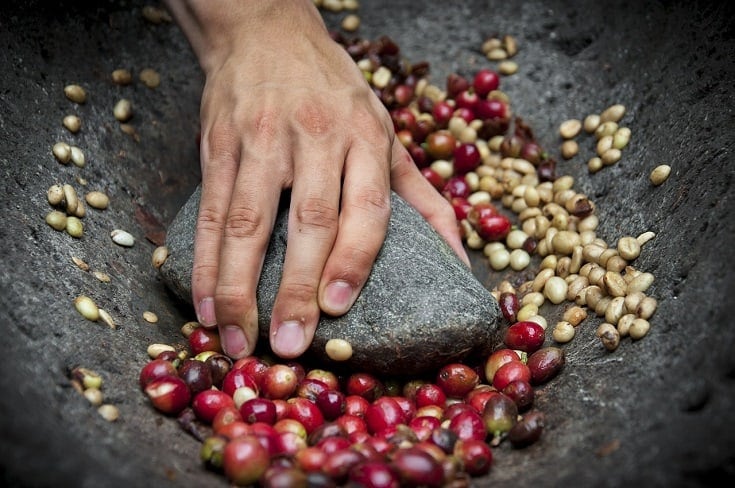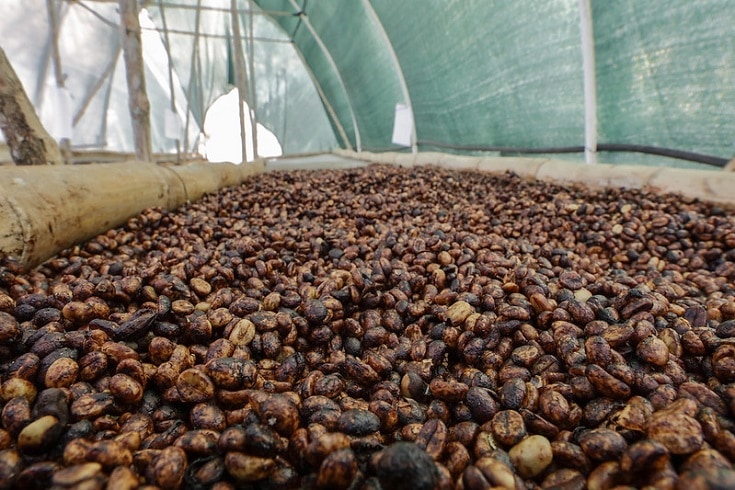
Coffee production is a fascinating process that many people take for granted. How does coffee get from the tree into my cup? What even is a coffee bean, to begin with? Most coffee drinkers never consider such questions, but as you get deeper into the world of coffee, it can help to know some of the details of what happens behind the scenes. Besides being interesting trivia, the specifics of the coffee production process have an enormous impact on your coffee’s taste.
In this article, we will give you an overview of what it means for a coffee to be honey-processed. We will start with a bit of background information so that everyone starts on the same footing, describe what honey-processed coffee is, and then explain why you should care how your coffee is processed. Let’s begin!

What is a coffee bean anyway?
Coffee beans are actually the seeds of a fruit called coffee cherries. Coffee cherries get their name from their resemblance to ordinary cherries. They grow on small, shrub-like trees, and when they ripen, they are harvested and prepared for processing.

Why does coffee need processing?
Modern society has conditioned us to associate the word “processed” with artificial and usually comes with a negative connotation. Coffee processing doesn’t introduce any foreign chemicals into the coffee bean and just refers to the literal process used to prepare the coffee bean for distribution and consumption.
After coffee cherries are harvested, the seed needs to be removed from the fruit. Traditionally, coffee fruit was left to dry in the sun before the seed was removed. Letting the fruit dry out before extracting the seed allows fermentation to occur, which gives coffee beans the complex, interesting flavors coffee aficionados love. Unfortunately, this natural process – sometimes called “dry processing” – takes a long time and limits production capacity.
An alternative method – called washed processing – removes the seed from the fruit immediately after harvesting and artificially ferments the beans by soaking them in water. Washed coffee is free from the randomness that plagues natural processed coffee. Irregularities in the fruit can drastically alter the flavor of natural process coffee, and each batch will be different. On the other hand, washed coffee is very consistent, and batch-to-batch differences are typically small.
Specialty coffee roasters prefer washed coffee because of this consistency, but also because it gives a more authentic representation of the bean’s flavor. Naturally processed coffee gets a large fraction of its taste from the fermentation process and the characteristics of the cherry itself. Washed coffee avoids these factors and exhibits the flavor of the bean in its purest form.

What is Honey Processing in Coffee?
Honey processing is a middle ground between natural processing and washed processing. Instead of completely removing the fruit – as washed processing does – the outer pulp is removed, but a sticky inner coating called mucilage is left behind during fermentation. The result is a coffee that is not as sweet and prone to variability as naturally processed coffee but also isn’t as clean tasting as washed process coffee.
An additional benefit of honey processing has to do with responsible management of resources and sustainability. Washed coffee uses large amounts of water, which increases the resource consumption and cost of producing coffee. Honey processed coffee skips the washing process, which saves a significant amount of water.

Types of Honey Processing
Under the umbrella of honey processing, there are several distinct types named after the degree of fermentation that happens before the process is stopped. The mucilage left on the seed in honey processed coffee has a golden yellow color and looks a lot like honey (hence the name).
As fermentation progresses, the mucilage changes color, getting darker over time. Coffee that is stopped relatively early in the fermentation process maintains its golden color and is called yellow honey process coffee. Coffee that ferments a bit longer gets a reddish hue and is called – you guessed it – red honey process coffee. The final level is the darkest color and is simply called black honey process coffee.
How long the seed ferments also determines the taste. The more time spent fermenting, the fruitier the flavor gets. Yellow honey process coffee is sweeter and fruitier tasting than washed process coffee but still retains some of the fingerprints of the origin’s characteristic flavor profile. Black honey processed coffee, on the other hand, is extremely fruity, and almost all of the bean’s natural flavor is swamped by the sweetness from fermentation.

Which type of processing is right for me?
This is a common question that can be hard to answer without knowing someone’s personal taste preferences. We know it seems like a cop-out, but the best way to decide which type of processing you like best is to try several different kinds and decide for yourself.
If you’re looking for some guidelines, the oversimplified explanation is that washed process coffee is the most representative of a bean’s intrinsic taste. Differences between where and how coffee is grown are most apparent in a washed process coffee.
As you step through the different levels of honey processing, coffees get fruitier and sweeter until you reach natural processing, which produces the most fruit-forward tasting coffee. Ordering the same naturally processed coffee twice will give you different experiences due to the variability of natural processing.
Our concrete recommendation is to buy a washed coffee and a naturally processed coffee and try them together. The differences between the two will be dramatic and give you a taste of what the extreme ends of the range have to offer. That will give you a good starting point and help you decide which processing style you like best.

Conclusion
This article is a very general review of coffee processing and honey processed coffee. It is far from exhaustive, but we hope you’ve found it informative and helpful. Coffee processing is a large part of the production pipeline and has a large effect on how coffee tastes.
If you’ve never paid attention to how your coffee is processed, it’s a good idea to look into it. Knowing what processing style you like best can help you choose coffees in the future. In many ways, honey processing offers a best-of-both-worlds approach to coffee production. Give it a try!
SEE ALSO: Where Do Coffee Beans Come From? The Seed to Cup Process
Featured Image: Maren Barbee, Flickr, CC by 2.0















